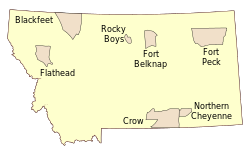Cree
The Cree (Néhiyaw in Cree language; French: [Cri] Error: {{Lang}}: text has italic markup (help) in French) are one of the First Nations in North America. They are one of the largest groups.
Néhinaw, Néhiyaw, etc. | |
|---|---|
| Total population | |
| 392,420 (2016 census) Including Atikamekw and Innu | |
| Regions with significant populations | |
| Canada, United States | |
| Alberta | 95,300 |
| Saskatchewan | 89,990 |
| Manitoba | 66,895 |
| Quebec | 58,640 |
| Ontario | 36,750 |
| British Columbia | 35,885 |
| Montana | 3,323 |
| Newfoundland and Labrador | 3,255 |
| Northwest Territories | 2,195 |
| Nova Scotia | 1,780 |
| Languages | |
| Cree, Cree Sign Language, English, French | |
| Religion | |
| Anglicanism, Pentecostalism, Roman Catholicism | |
| Related ethnic groups | |
| Métis, Oji-Cree, Ojibwe, Innu | |
In Canada, over 350,000 people are Cree or have Cree ancestors.[2] Most Cree in Canada live in Ontario, Manitoba, Saskatchewan, Alberta and the Northwest Territories.[3] About 27,868 of them live in Quebec.[4]
During their history in the United States, Cree people lived west of Lake Superior. Today, they live mostly in Montana, in the Rocky Boy Indian Reservation.[5] Ojibwe (Chippewa) people also live in that reservation.[5]
They have moved west over time because they were traders and hunters.[6]
Cree Media
Nēhiyaw (Plains Cree) camp near the future site of Vermilion, Alberta, in 1871
Chippewa Cree Tribal Chairman Raymond Parker, Jr. signs an agreement with the FEMA in Rocky Boy's Indian Reservation, Montana on August 17, 2010.
Hudson Bay Cree use decoction.
References
- ↑ "Canada - Indigenous Peoples (Canada)".
- ↑ "2016 Canadian Census". Statistics Canada. 21 June 2018. Retrieved April 28, 2019.
- ↑ "Cree". The Canadian Encyclopedia.
- ↑ "2016 Canada Census". Statistics Canada. 21 June 2018. Retrieved April 28, 2019.
- ↑ 5.0 5.1 "Gateway to Aboriginal Heritage". Canadian Museum of Civilization Corporation.
- ↑ Alexander Mackenzie, [1] Voyages from Montreal Through the Continent of North America to the Frozen and Pacific Oceans in 1789 and 1793.








